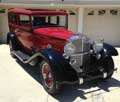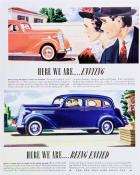|
The Final Answer...
|
||||
|---|---|---|---|---|
|
Home away from home
|
Hi All,
I have been posting for a couple of years now and have been trying to figure out what is wrong with my '39 Six, which has exhibited a chronic stalling issue since I bought it in early 2016. Not being a mechanic and not being able to find competent help, living in a rural area, I have engaged in the age-old 'trial and error' approach, replacing virtually everything under the hood but the engine. Different so-called 'mechanics' have run various engine 'health' tests on the motor, one being a compression test and I took their 'supposed' findings at face value. I was told the cylinders tested all the same and all were in and around 100/105#'s compression. Although this a bit low, I thought it was just an old motor with some wear and that the problem must be ulterior to the motor. I eventually gave up and decided to pull the block out and have it professionally rebuilt. The rebuilders findings were quite stark. They said it looked like the engine had been properly rebuilt many years ago, with a .30 thou over-bore and new standard shells and mains. Then, also, quite some time ago, the motor was the victim of a 'backyard rebuild' that was a little short of murder in the 1st degree. One cylinder had piston clearance of .45 thou with high to extreme wear on the others. The tech said, it was virtually impossible for the engine to have exhibited 'uniform compression' and at least the one cylinder would have had very little. Thankfully the thing is within spec to rebuild and they bored the worst cylinder to .60 thou over original bore and it 'cleaned up' just fine. Not sure what the second rebuild did as far as boring, other than to say it was botched. The rebuild house says those pre-war era castings are very thick and can take up to .80 thou before sleeving is necessary. Long story short, that was the answer to my stalling woes and the guy says he has seen this time and again with Continental flathead 6's from forklifts with very high hours on them, and the stalling symptoms are identical to what I was experiencing. Thought I would post an update and as I progress with the re-install I will no doubt have a couple of questions, so will post my progress as I ask those, with many thanks to all the folks that put up with my frustration in trying to track this thing down for the last couple of years. Hopefully, my car will 'run like a Packard' once I get it back together and I can enjoy it, as was my intention when I fell in love with it and bought it.
Posted on: 2018/10/8 16:00
|
|||
|
'If you think you can, or you think you can't - you're right!' Henry Ford.
1939 Packard Six, Model 1700 |
||||
|
||||
|
Re: The Final Answer...
|
||||
|---|---|---|---|---|
|
Home away from home

|
Sorry to hear about your woes. Have you posted this before out this web site? I would be interest to know that after it stalls if it starts right up and if it only stalls when hot or both hot or cold?
Please post as much as possible about the stalling that you can. I think RScott is pointing you in the right direction in the problem seems to be electrical. It could very well be the switch because as they get old sometimes they just loose contact. I have friend that had a cutout problem after a restoration/engine replacement. The mechanic did not tighten the nut on the switch. This was discovered after four trips to several shops. I suggest downloading an electrical diagram and checking all of the points in the "Ignition" portion looking for loose connections and dirty rusted/corroded points. Clean and tighten as needed. Also, where there are those crimped on connectors ensure that there is good contact (That's why I always recommend crimp and then solder). Of course, you can always start the car up and start carefully wiggling those wires around to see if it cuts out. But careful to avoid those nasty spark plug wires. Good Luck playing Sherlock Holmes.
Posted on: 2018/10/10 18:35
|
|||
|
||||
|
Re: The Final Answer...
|
||||
|---|---|---|---|---|
|
Home away from home
|
Hi Marty,
Thanks for the reply. I have posted on the issue ad nauseam and there is a thread entitled 'Return to Forever - the Stalling Issue', in which I outlined in detail, the exact symptoms of the car's performance woes. Bottom line, the engine would start, idle nicely, rev fine, and go great in 1st and 2nd gear on level ground. After that, any uphill load, or trying to get up to highway speed in high gear, the thing would bog and as soon as I came to a stop, the motor would quit. And when I say 'quit', it would just 'coast to a halt' with no sputter or miss, it just lost revs until it wasn't running. Wait 30 to 45 seconds and it would fire right up again and one could repeat that cycle all day long, but needless to say, that is no fun or any way to 'enjoy the Packard'. Re your electrical suggestions, that is something that has been submitted before as a possible solution and I have bypassed the ignition switch with an alligator clip on the main, large hot wire from the battery to the coil and it did not effect any difference. Nor did any other of the dozens of things I tried and parts I have replaced; thus the decision to rebuild. And, from the evaluation of the machine shop, the engine had SERIOUS cylinder wear issues, the wrong rings, significant wear in the valve timing train, all of which could combine to cause the aforementioned symptoms. I will get the engine back, reinstalled and fired up and see where I am. Hopefully, things will be different. Thanks again for your interest. Chris
Posted on: 2018/10/11 20:49
|
|||
|
'If you think you can, or you think you can't - you're right!' Henry Ford.
1939 Packard Six, Model 1700 |
||||
|
||||
|
Re: The Final Answer...
|
||||
|---|---|---|---|---|
|
Home away from home

|
I'm glad I missed out on this one.
Posted on: 2018/10/12 18:15
|
|||
|
||||
|
Re: The Final Answer...
|
||||
|---|---|---|---|---|
|
Home away from home
|
Other than the fact that I have learned a tremendous amount and met some great people through this site, I sometimes wish I had missed out on it too, Tim!
Posted on: 2018/10/12 18:44
|
|||
|
'If you think you can, or you think you can't - you're right!' Henry Ford.
1939 Packard Six, Model 1700 |
||||
|
||||









